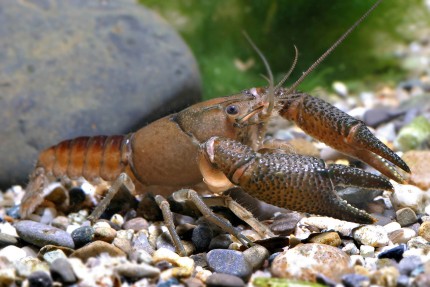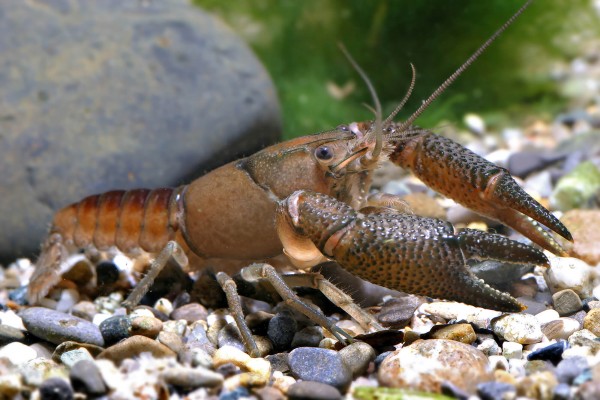- Item no: 5458
Fast delivery times
All products are in stock with us!14 years of breeding experience
Let our team of experts advise you!High customer satisfaction
from over 3,000 reviews "The Procambarus vasquezae is a relatively small remaining Procambarus species from Mexico. It is found exclusively in the Laguna de Catemaco in the state of Veracruz. With a life expectancy of 2 - 3 years, sexual maturity occurs after 3 months. The females grow up to 6 cm, the males remain somewhat smaller. Temperatures in the lake vary with the seasons between 18 and 26 °C. Procambarus vasquezae inhabits the rather cool and muddy bottom of the water up to 2m depth. This crayfish is dark brown to slightly brown-bluish, striking are the bulky claws with black tubercles, which appear very large in relation to the body, especially in males.
Procambarus vasquezae should be kept in a well structured aquarium with an edge length from 60 cm. With a pH of about 7 - 9 and a water hardness of 10 to 25 dGH, one pair can be kept in this aquarium size. The aquarium must have a lot of structure, so that the loners can avoid each other if necessary - especially during and shortly after molting. Hiding places can be constructed from rocks, clay tubes, or root wood (or a combination thereof). Since Procambarus vasquezae digs, the structures should be constructed collapse-proof. It is important to always have more hiding places than crayfish in the tank. It is also important to cover the aquarium absolutely escape-proof - crayfish are climbing artists and like to go wandering - and they find every gap, no matter how small!
Breeding in the aquarium is not difficult. After mating, the female presses out up to 40 black eggs and attaches them under her abdomen. During the gestation period the female does not show up often in the aquarium, she also does not eat much during this time. After three to five weeks the small fully developed crabs hatch. They remain under the mother's pleon for a few hours to days and then move around the aquarium on their own. Since small crayfish can be very cannibalistic, hiding places are now necessary. Brown autumn leaves are always very popular with small and large crayfish as hiding places, perforated bricks and ceramic or sintered glass rolls are also perfect. If enough hiding places are available, the young can be left with the parents in the tank.
Procambarus vasquezae is an omnivore. Sinking food tablets and special crayfish food as well as vegetables and frozen food are best. Brown fall foliage is also high on the menu, it promotes healthy molting. Snails are very readily cracked and eaten.
The Procambarus vasquezae is a peaceful representative of its genus. It can be kept very well together with fish, and it is not aggressive within the species. Moreover, it leaves the plants in the aquarium alone. It should not be kept together with other crayfish, large-armed shrimps and crabs - the stress associated with this would lead to illness and premature death. It is possible to keep it together with peaceful, to medium sized fish and with dwarf shrimps. Snails are eaten.
Since this crayfish, like all North American crayfish, can potentially transmit crayfish plague, which is absolutely lethal to all native European crayfish, it must be ensured that neither the crayfish themselves can escape into the wild, nor can water from the aquarium escape into natural waters.
Our food recommendation: Freshwater crayfish have a very varied diet in the wild. The Natureholic Crayfish Feed Sticks contain in a biologically balanced form only those ingredients that these crayfish in this or similar form to their natural food spectrum. This naturally supports and promotes moulting, growth and reproduction. Due to their protein content they are ideally suited for omnivorous crayfish of the genera Procambarus, Cambarus, Cambarellus, Astacus and the Cherax crayfish from Australia, which are basically omnivores that like to eat animal as well as vegetable food. The crayfish of the genus Cherax from Papua also like to eat a portion of animal food when they are young, but later they switch mainly to plant food.
Our plant recommendation: Use for planting NatureHolic InVitros. These are free of snails, planaria and other unwanted co-inhabitants. Also free of algae spores, bacteria and fungi.
Expert Tip: We recommend for fish keeping the NatureHolic 3 Phase Liquid. The care set offers the best all-round protection for your animals. It ensures optimal conditions for successful breeding and keeping.
| Scientific name: | Procambarus vasquezae Villalobos, 1954 |
| German name: | Vasquez crab |
| Difficulty level: | suitable for beginners |
| Origin/Distribution: | Veracruz, Mexico |
| Coloration: | dark brown to brownish-bluish, large claws with black tubercles |
| Age expectancy: | 2-5 years |
| Water parameters: | GH 10 to 25, KH 3 to 20, pH 7 to 9, temperature 18 to 26 °C |
| Tank size: | from 54 l |
| Food: | Natureholic crayfish food, brown autumn leaves, nettles, flake food, granulated food or food tabs, vegetables, frozen food |
| Reproduction: | easy, after three to five weeks up to 40 young crayfish hatch, they are quite cannibalistic and therefore need lots of hiding places |
| Behavior: | little aggressive |
| Socialization: | with shrimp, with peaceful to medium sized fish |
| Further information | Sex differences crayfish, shrimp, crayfish, snails & mussels feed properly, Cherax aquarium crayfish - keeping in the aquarium |
- Item no: 5458
Entdecke die Garnelio Welt!
Garnelio gehört zu den größten Onlineshops für wirbellose Aquarientiere weltweit.
Viele Artikel gibt es exklusiv nur bei uns im Shop.
















